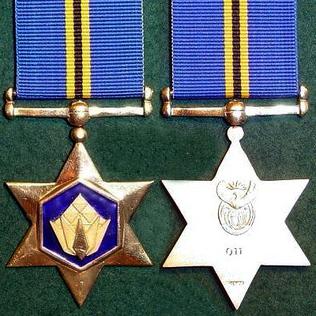
The iPhrothiya yeGolide - Golden Protea, post-nominal letters PG, was instituted by the President of the Republic of South Africa on 16 April 2003 and came into effect on 27 April 2003. It can be awarded to all ranks who have distinguished themselves by exceptional leadership or exceptional meritorious service and the utmost devotion to duty. It is South Africa's highest existing military decoration for meritorious conduct.
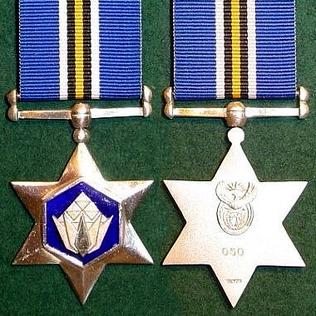
The iPhrothiya yeSiliva - Silver Protea, post-nominal letters PS, was instituted by the President of the Republic of South Africa on 16 April 2003 and came into effect on 27 April 2003. It can be awarded to all ranks who have distinguished themselves by outstanding leadership or outstanding meritorious service and particular devotion to duty. It is South Africa's second highest existing military decoration for meritorious conduct.

The iPhrothiya yeBhronzi - Bronze Protea, post-nominal letters PB, was instituted by the President of the Republic of South Africa on 16 April 2003 and came into effect on 27 April 2003. It can be awarded to all ranks who have distinguished themselves by leadership or meritorious service and devotion to duty.

The Van Riebeeck Medal, post-nominal letters VRM, is a military decoration for bravery which was instituted by the Union of South Africa in 1952. It was awarded to other ranks for distinguished service in the field.
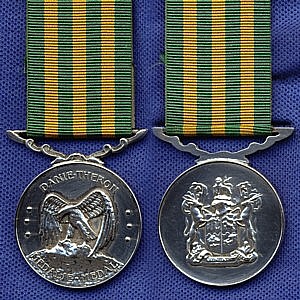
The Danie Theron Medal, post-nominal letters DTM, is a military decoration which was instituted by the Republic of South Africa in 1970 and which was in use until 1993. It was awarded for diligent service in the Commandos, the rural defence component of the South African Defence Force. Originally reserved for officers, it was available to all ranks from 1975.

The Jack Hindon Medal, post-nominal letters JHM, is a South African military decoration which was instituted in the Republic of South Africa in 1970 and which was only in use until 1975. It was awarded to other ranks for diligent service in the Commandos, the rural defence component of the South African Defence Force.

The Southern Cross Decoration, post-nominal letters SD, is a South African military decoration for merit which was instituted by the Republic on 1 July 1975. It was awarded to officers of the South African Defence Force for outstanding service of the highest order and utmost devotion to duty.

The Pro Merito Decoration, post-nominal letters PMD, is a military decoration for merit which was instituted by the Republic of South Africa on 1 July 1975. It was awarded to other ranks of the South African Defence Force for outstanding service of the highest order and utmost devotion to duty.

The Southern Cross Medal of 1975, post-nominal letters SM, is a military decoration which was instituted by the Republic of South Africa on 1 July 1975. It was awarded to officers of the South African Defence Force for exceptionally meritorious service and particular devotion to duty.

The Pro Merito Medal of 1975, post-nominal letters PMM, is a military decoration which was instituted by the Republic of South Africa on 1 July 1975. It was awarded to other ranks of the South African Defence Force for exceptionally meritorious service and particular devotion to duty, and was the non-commissioned officers' version of the Southern Cross Medal of 1975 (SM).
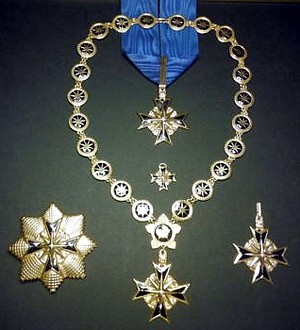
The Star of South Africa, Gold, post-nominal letters SSA, is the senior decoration of two military and five non-military classes of the Order of the Star of South Africa, a South African Order which was instituted in 1975, and awarded to general and flag officers of the South African Defence Force. The Order of the Star of South Africa was discontinued in 2002.

The Defence Force Commendation Medal was instituted by the State President of the Republic of Bophuthatswana in 1982. It could be awarded to all ranks for service of a high standard.

The Sandile Decoration, post-nominal letters SD, was instituted by the President of the Republic of Ciskei in 1988, for award to all ranks for meritorious service.
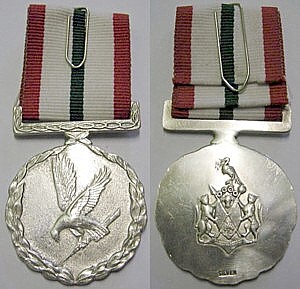
The Sandile Medal was instituted by the President of the Republic of Ciskei in 1988, for award to all ranks for meritorious service.

The Chief C.D.F. Commendation Medal was instituted by the President of the Republic of Ciskei in 1992, for award to all ranks for service commended by the Chief of the Ciskei Defence Force.

The Decoration for Merit in Gold, post-nominal letters DMG, was instituted by the President of the Republic of South Africa in April 1996. It was awarded to veteran cadres of uMkhonto we Sizwe, the military wing of the African National Congress, who had distinguished themselves during the "struggle" by outstanding service and utmost devotion to duty.

The Merit Medal in Bronze, post-nominal letters MMB, was instituted by the President of the Republic of South Africa in April 1996. It was awarded to veteran cadres of uMkhonto we Sizwe, the military wing of the African National Congress, who had distinguished themselves during the "struggle" by service of a high order.

The Gold Decoration for Merit, post-nominal letters GDM, was instituted by the President of the Republic of South Africa in April 1996. It was awarded to veteran cadres of the Azanian People's Liberation Army, the military wing of the Pan Africanist Congress, for outstanding service and utmost devotion to duty during the "struggle".

The Silver Medal for Merit, post-nominal letters SMM, was instituted by the President of the Republic of South Africa in April 1996. It was awarded to veteran cadres of the Azanian People's Liberation Army, the military wing of the Pan Africanist Congress, for exceptionally meritorious service and particular devotion to duty during the "struggle".

The Bronze Medal for Merit, post-nominal letters BMM, was instituted by the President of the Republic of South Africa in April 1996. It was awarded to veteran cadres of the Azanian People's Liberation Army, the military wing of the Pan Africanist Congress, for service of a high order during the "struggle".






















